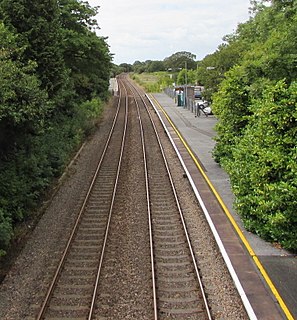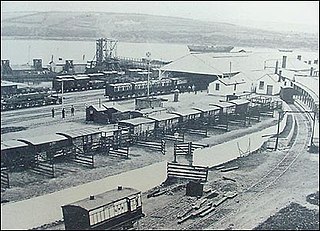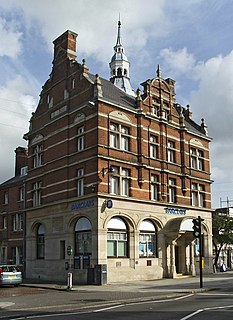Related Research Articles

Pembrokeshire is a county in the southwest of Wales. It is bordered by Carmarthenshire to the east, Ceredigion to the northeast, and the sea everywhere else.

The Old Red Sandstone is an assemblage of rocks in the North Atlantic region largely of Devonian age. It extends in the east across Great Britain, Ireland and Norway, and in the west along the northeastern seaboard of North America. It also extends northwards into Greenland and Svalbard. These areas were a part of the ancient continent of Euramerica/Laurussia. In Britain it is a lithostratigraphic unit to which stratigraphers accord supergroup status and which is of considerable importance to early paleontology. For convenience the short version of the term, ORS is often used in literature on the subject. The term was coined to distinguish the sequence from the younger New Red Sandstone which also occurs widely throughout Britain.

Milford Haven is a town and community in Pembrokeshire, Wales. It is situated on the north side of the Milford Haven Waterway, an estuary forming a natural harbour that has been used as a port since the Middle Ages. Founded in 1790 by Sir William Hamilton, designed to a grid pattern, it was originally intended to be a whaling centre, though by 1800 it was developing as a Royal Navy dockyard which it remained until the dockyard was transferred to Pembroke in 1814. It then became a commercial dock, with the focus moving in the 1960s, after the construction of an oil refinery built by Esso, to logistics for fuel oil and liquid gas. By 2010, the town's port had become the fourth largest in the United Kingdom in terms of tonnage, and continues its important role in the United Kingdom's energy sector with several oil refineries and one of the biggest LNG terminals in the world.

The West Wales lines are a group of railway lines from Swansea through Carmarthenshire to Pembrokeshire, West Wales. The main part runs from Swansea to Carmarthen and Whitland, where it becomes three branches to Fishguard, Milford Haven and Pembroke Dock.

Clunderwen railway station serves the village of Clynderwen in Pembrokeshire, Wales. The station is unmanned. It is a request stop.

Milford Haven Waterway is a natural harbour in Pembrokeshire, Wales. It is a ria or drowned valley which was flooded at the end of the last Ice Age. The Daugleddau estuary winds west to the sea. As one of the deepest natural harbours in the world, it is a busy shipping channel, trafficked by ferries from Pembroke Dock to Ireland, oil tankers and pleasure craft. Admiral Horatio Nelson, visiting the haven with the Hamiltons, described it as the next best natural harbour to Trincomalee in Ceylon and "the finest port in Christendom". Much of the coastline of the Waterway is designated as a Site of Special Scientific Interest, listed as Milford Haven Waterway SSSI.

Charles Francis Greville PC FRS FRSE FLS FSA was a British antiquarian, collector and politician who sat in the House of Commons from 1774 to 1790.
David Morris & Sons was a bank which was established in Carmarthenshire, Wales in the 18th century. It now a constituent part of The Royal Bank of Scotland Group.
J. Dunn & Co., Tenby was a Welsh bank operating in the 19th century, with a branch located at Tenby in Pembrokeshire.
Haverfordwest Bank is a defunct Welsh bank which was located in Haverfordwest, Pembrokeshire. It was established in the 18th century by a Jewish entrepreneur who settled in Wales.
Union Bank was a bank operated by the firm of Bateman & Co. and it is listed in the London Directory for 1807. However, the date of establishment of the bank is unknown.
This Bank was probably founded in 1802. It was established in Pembrokeshire, with a branch at Milford and was one of the banks founded as a result of the Bank of England stopping cash payments in 1797.
This bank was operating in Pembrokeshire, in Wales during the early 19th century. It became bankrupt in 1826.

Hubberston is a coastal village in Pembrokeshire, Wales. It belongs to the parish of Hubberston in the historical hundred of Roose. It is located directly to the west of the larger town of Milford Haven, and is a district of the community of Milford Haven. It is adjacent to the village of Hakin. It had a population of 2,390 inhabitants in 2001. It is mainly residential in nature.
The town of Milford Haven was founded in 1793 by Sir William Hamilton, who initially invited Quaker whalers from Nantucket to live in his town, and then, in 1797, the Navy Board to create a dockyard for building warships.

Neyland railway station was on the north bank of the Milford Haven Waterway in Pembrokeshire, Wales.

Pill Priory is a Tironian house founded near Milford Haven, Pembrokeshire, South West Wales in the late 12th century.

Pembrokeshire has been called "the cottage garden of Wales", due to its good soil and the beneficial effects of the Gulf Stream, which provide a mild climate and a longer growing season than other parts of the country. The good climate and soil meant that the south of the peninsula was coveted by the Norsemen and Normans because it had "great plentie" of corn and cattle The county has prime agricultural land, much of which is located at about 70m above sea level, while to the north, the Preseli Hills rise to 500m above sea level and form uplands that are made up of heather and bracken, which are used for grazing sheep. Consequently, Pembrokeshire is classed as one of the most fertile counties in Wales, with its 392,300 agricultural acres having 14% of its land classed as of good quality, 67% being classed as medium quality and 19% being classed as poor quality. However, agricultural production is subject to market forces and in the 1890s, as a result of the Panic of 1893, a deep agricultural depression led to the area under cultivation falling by a third. Many labourers and farmers had no option but to emigrate to the New World and many of the large farming estates were sold. World War I brought prosperity again, but by the 1930s, as a result of the Great Depression, there was another agricultural depression which lasted until World War II. During the Post-war period agriculture has benefited from marketing schemes and marketing boards, which have helped in the regulation, marketing and distribution of the county's agricultural production.

The London and Provincial Bank, originally known as the Provincial Banking Corporation, was established in 1864.

Benton Castle is a small fortification in the community of Burton, Pembrokeshire, Wales, now in use as a private house, in a wooded area overlooking the Cleddau river.
References
- 1 2 3 Early Banks in West Wales, by Francis Green (in West Wales Historical Records, The Annual Magazine of The Historical Society of West Wales, Volume VI, edited by Francis Green, Printed by W. Spurrell & Son, 1916)
- ↑ "Constituent Banks" (PDF). Barclays. Archived from the original (PDF) on 17 February 2012.